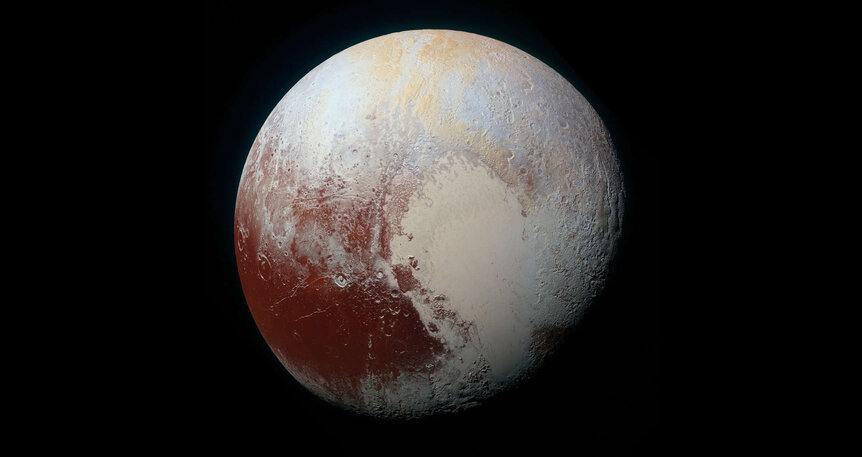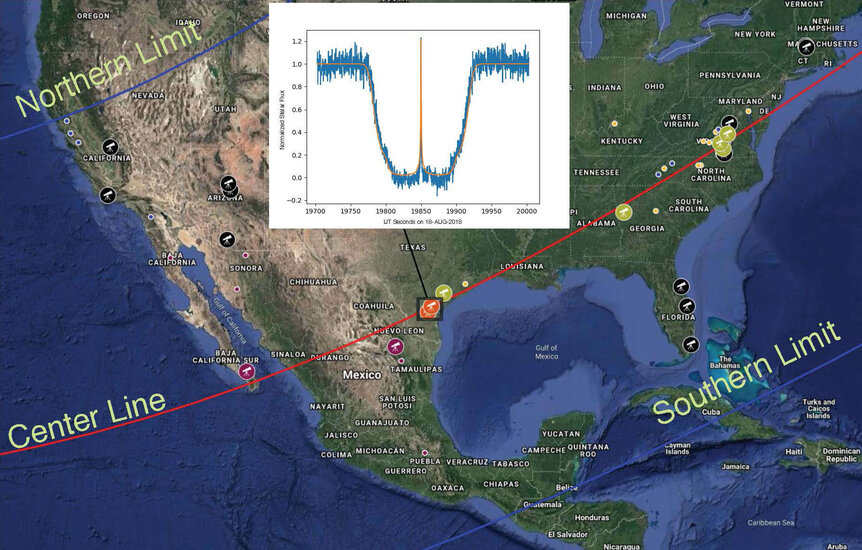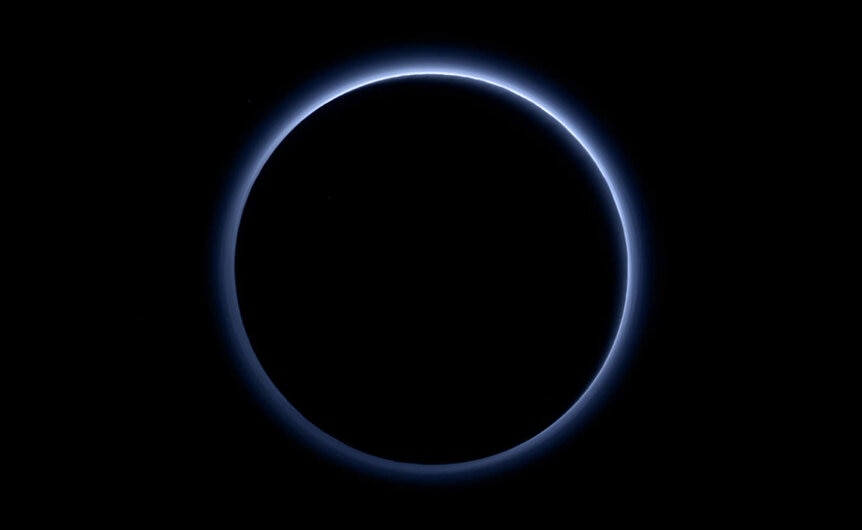We got to Pluto just in time: Its air is starting to freeze out

The New Horizons mission to the outer solar system flew past Pluto in July 2015, skimming over its surface by just 12,500 kilometers after a journey of 5 billion kilometers and returning incredible images and data of the tiny, icy world.
The mission was conceived, designed, built, and launched in record time because scientists wanted to get to Pluto as rapidly as possible. Why? Because Pluto orbits the Sun on a decently elliptical path, and around the year 1989 it was its closest point to the Sun. After that, as it slowly pulled away on its 248-year orbit, it would get slowly colder. Pluto has an incredibly thin nitrogen atmosphere, just 1/100,000th as thick as Earth’s, but it’s there. As the temperature dropped, though, scientists worried it would freeze out by the time a probe got there.
As it turns out, they made it just in time. The atmosphere, such as it is, was still doing its thing when New Horizons zipped past. By 2018, however, there was evidence that the atmosphere was beginning to condense.
On August 15, 2018, as seen from Earth, Pluto passed directly in front of the star UCAC4 341-187633, which is only a little brighter than Pluto itself. An event like this is called an occultation, and these can be extremely useful to astronomers; sometimes giving the size and even the shape of the occluding object.
For an occultation, timing and location are everything. It makes a path across the Earth, like for a solar eclipse, and inside that path you see it while outside you don’t. For the 2018 Pluto occultation the southern limit was Belize and Guatemala in Central America, and the northern limit cut across the northern United States. The central line, where the star would pass right through Pluto’s middle, cut across Mexico, the Gulf Coast, and then up to the eastern Atlantic states.
Quit a few observers were able to measure the star’s brightness. If Pluto had no atmosphere the star brightness would drop very rapidly as the solid body of the world passed in front of it. But the atmosphere is there and actually reaches quite high off the surface, so the star dimmed gradually and rose again in brightness over time. This can tell scientists about the vertical structure of the atmosphere, which is extremely useful in characterizing it.
The plot displayed in the diagram here also shows a sharp uptick in brightness right in the middle of the event. Air bends light, just like how a spoon look bent in a glass of water. This is called refraction. When the star was exactly on the other side of Pluto, directly behind the center of Pluto, the air all around the edge of the world bent the starlight toward the observer, causing what’s called a central flash. If you had been looking through a telescope big enough, it would’ve looked like Pluto was surrounded by a bright ring of light. This is commonly seen in occultations where the occluding object has an atmosphere; it’s happened with Neptune’s moon Triton for example. This flash can also tell astronomers a lot about the atmosphere of the object.
So what were the results? When New Horizons passed Pluto in 2015 the atmosphere had actually been getting thicker, doubling in surface pressure every decade. The spacecraft measured a surface pressure of about 11.5 microbars (11.5 millionths of Earth sea level pressure). Given the trend, the 2018 measurement was expected to be more than 14 microbars.
It wasn’t: The occultation yielded a pressure of 11.4 microbars, almost exactly the same as what New Horizons saw. This indicates the increasing pressure trend has finally stopped.
Pluto’s atmosphere isn’t like Earth’s, where an equilibrium has been reached and the pressure stays relatively constant*. Pluto’s atmosphere is generated by nitrogen ice on the surface warming up and sublimating, turning into a gas. The rate at which this happens is steeply dependent on temperature. Pluto’s orbit takes it from as close as 4.5 out to 7.5 billion kilometers from the Sun, so it gets nearly three times as much sunlight when it’s at perihelion (closest to the Sun) then aphelion (when it’s farthest). This means that as it starts to move farther out the temperature drops enough that the nitrogen stops sublimating and the process reverses, with the nitrogen gas in the air starting to freeze back out.
But why now? After all, Pluto was closest to the Sun nearly 30 years before the occultation!
The reason is thermal inertia. Pluto was receiving the maximum amount of sunlight in 1989, but even as it (very slowly) moved farther away from the Sun it was still receiving sunlight, and heating up faster than it could radiate away that warmth (well, -230° C isn’t exactly warmth but you know what I mean). So it took a while before it could actually start cooling once again. That must have started only shortly after New Horizons got there.
Nice timing. I’ll note that an occultation in 2015, right before the New Horizons flyby, showed the atmosphere was not collapsing, and the results were released in 2020 (and published in early 2021). So it’s funny to me that as those observations were being analyzed, the 2018 occultation was already showing the air was collapsing! Sometimes science takes a while and results can cross paths.
If the 2018 occultation results showing the atmosphere starting to freeze are correct, then Pluto is finally starting to cool off after getting as close to the Sun as it can. Its orbit will take it farther out over the decades, and when it next reaches aphelion — around the year 2213 — it will be about as cold as it gets. The atmosphere will have mostly frozen out, and will likely stay that way for a century more before slowly starting to puff up again as meager sunlight warms the surface.
Hopefully we’ll have sent more probes (maybe even people) long before then.
*There are some similarities; both are mostly nitrogen, and both can create blue skies. Also, Earth’s air does freeze out a little; that’s how we get snow. But that happens in winter, which is due to Earth’s axial tilt and not so much its distance from the Sun.































